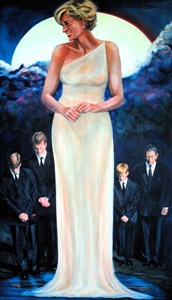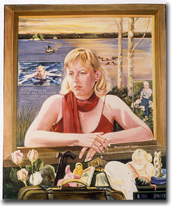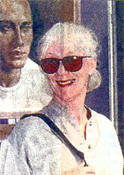|
Articles
PORTRAIT OF A PARADOX
The news of Princess Diana's tragic death on August 31, 1997, left me, like many others, in a state of shocked disbelief. My intense reaction to her death was totally disproportionate to the passing interest her life had held for me.
Mystified by the personal and universal manifestations of grief, I started to paint the princess whose death seemed destined to be her most defining moment.
Curious about the parts of myself that were projected onto this beautiful young woman whose life was becoming an instant legend, the painting became a private exploration in search of a larger truth.
Diana emerged on canvas larger than life, a modern goddess. Regally engaged, provocatively attuned, she towers above an uprushing sea, her head and shoulders silhouetted by the brilliant arc of a full moon. The water from which the statuesque princess soars describes an arch of sadness. The arrow of projection that pierced the princess in life floats behind her in death; its potential for delivering displaced expectations temporarily subdued within the unconscious waters. I painted each grieving figure in layers, returning again and again to the depths of their pain. I touched William's unspeakable loss, Earl Spencer's tightly held anger, Harry's utter incomprehension, Charles' unreachable sorrow. I found discord beneath the dark-suited solidarity, reverence in the four pairs of shiny shoes, agony in each solitary stance. Diana is less complicated, her depths almost transparent. Her naked vulnerability seems consistent with her pose. I let her right shoulder articulate the ambiguity that so frustrated the paparazzi; her shrug expresses both easy flirtation and instinctive fear. It is a fluid shrug, a Cancerian shrug -- the gesture of a woman ruled by the moon, at home in the water, comfortable with paradox.
I discovered a Diana destined, by the magnificent limitations of her particular daimon, to live life fiercely, to use it fully.
Diana was, by nature, a perfect target for our collective projections, an ideal carrier for our greatest hopes and fears. How deep our need for her ... how understandable our grief.
Today, on the first anniversary of her death, replete with so many either/or theories on who she was, why she was, etc., the thoughts that informed and explained the painting seem terribly simple.
They might resonate with many readers who feel no need to dissect and label Diana, who feel rather a respectful and perplexing sadness concerning the events -- the social realities -- that shaped her life and led to her tragic death.
|
|
By Lenore McGovern SPECIAL TO THE STAR
I make my living painting portraits. Not a lavish living, but enough to keep me going -- to pay the rent and to put my feet on the floor each morning with a joyful sense of purpose. It is the realization of a lifelong dream. As a commissioned portrait artist, I am part of an old tradition, a risky tradition whose prestige and popularity fluctuates to the extreme. Throughout most of the past century, portraiture appeared to be more dead than alive. The news that the genre is making a comeback in the art world, becoming a status symbol and reinventing itself in its official role in the halls of places like Queen's Park, is exciting. It's about time. There's no doubt in my mind that this revival has been generated largely by aging baby boomers. And they are putting their particular stamp on this time-honoured tradition. In the same way they transformed marriage ceremonies and funeral rites, baby boomers are breathing new life into this notoriously stuffy art form by demanding new works incorporate an element of personal celebration. Personality has begun to take precedence over position, as we can see for example in the portrait of former Ontario premier Bob Rae unveiled last March at Queen's Park: the artist down-played the politician and, instead, gave to posterity a fleshed-out narrative of a particular person who happened to be a premier. There is always a fear that the outcome will fall short This new emphasis brings a refreshing accessibility to the finished painting. It does not, however, alter the nature of the commitment at the heart of portraiture: it involves an act of great trust. Because a portrait addresses the fundamental question of "Who am I?" there is always a fear that the outcome will fall short of expectations -- a fear that must be endured until the moment of unveiling. Entirely reasonable, a subject's fear centres on the hope that the artist will take proper licence with a few extra pounds and at least five years. The commissioned portrait artist honours the fears and hopes of each client. The goal is to reward the trust with an image that is truer than the mirror, kinder than the photograph and more enduring than the reflection in a lover's eyes. It is a tall order. Likeness, of course, is central to the success of a commissioned portrait. The most crucial element of likeness is character; recognizing it and incorporating it into a painting is always the ultimate challenge. A focus on character leads naturally to storytelling and, in my case, at least partially explains the growing importance of narrative in my portraits. I call my portraits Visual Biographies. |
We search for a metaphor that will define the work I work closely with my subject, especially at the beginning. We talk, we look through photo albums. I listen a lot, make sketches, take pictures. We search for a metaphor that will define the work and sort through details that will articulate the story. It is a unique collaboration, open and creative. This is when I feel comfortable and confident. By the time I approach the canvas, however, I do so with the sense that I have never done this before. And, of course, I haven't. Each subject is still a mystery. Though the composition and its components have been roughly worked out, ahead of me is a roller coaster ride -- one that has yet to derail me but still fills me with fear and excitement. The utter arrogance of what I am attempting hits me hard at this point in the process: What makes me think that I can translate to two dimensions the multi-dimensional complications and contradictions that form us all and are so uniquely arranged in the person who sits before me? I get over the almost paralyzing doubts as I get into the work. But there are often times before I finish that I toy with the idea of painting flowers or boats and ask myself, "Why people?" I don't take a lot of time musing on alternatives. We paint what we love. In the end a portrait says, "This is how you, the subject, seem to me." That statement, which I work on for at least two months, will be assessed by many eyes in the future, but it is the eyes of the subject that I watch at the unveiling. I hold my breath. Silence reigns in this moment of truth. The first human sound is a gasp, the next is that of my thankful, protracted exhaling. And then, as it was at the beginning, artist and subject become co-creators: We clink our glasses of wine in mutual congratulations. Still, the portrait does not definitely answer the question "Who am I?" "Who is that?," on the other hand, is full of possibilities. It is the question I imagine a child asking ages from now as he looks up at the portrait and sees it for the first time. The answer will be the story, the connective story that grows richer with every telling. The revival of portraiture is bound to lead to more and more images of ancestors filling our walls. The baby boomers will see to it. As they start to retire, their stories, their place in the scheme of things, will become of major importance. Like the ancient Egyptians, they will have themselves rendered for posterity at the height of their beauty and power. The modern quest for everlasting life augers well for the popularity of portraiture. |


 LENORE
MCGOVERN
LENORE
MCGOVERN